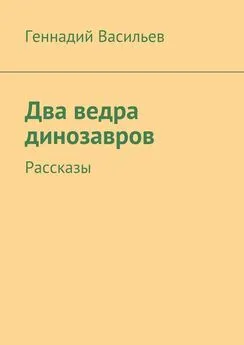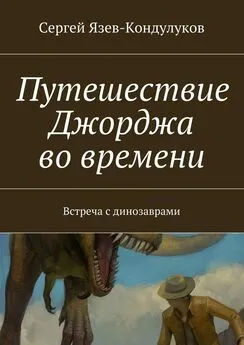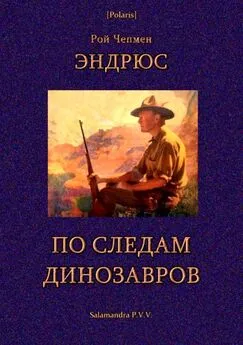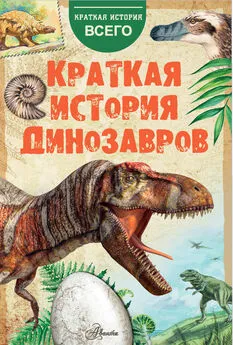Джордж Пойнар - Кто кусал динозавров?
- Название:Кто кусал динозавров?
- Автор:
- Жанр:
- Издательство:Princeton University Press
- Год:2007
- Город:Princeton, New Jersey
- ISBN:978-0-691-12431-5
- Рейтинг:
- Избранное:Добавить в избранное
-
Отзывы:
-
Ваша оценка:
Джордж Пойнар - Кто кусал динозавров? краткое содержание
В книге имеются чёрно-белые фотографии и рисунки. К сожалению, по причинам, не зависящим от переводчика книги, в ней отсутствуют упоминаемые в тексте многочисленные цветные вкладки. Может быть, когда-нибудь…
Кто кусал динозавров? - читать онлайн бесплатно полную версию (весь текст целиком)
Интервал:
Закладка:
112.Jeannel, R. 1942. La Genèse des Faunes Terrestres. Press Univ. de France, Paris, 513 pp.
113.Benton, M. J. 1984. The Dinosaur Encyclopedia. Simon & Schuster, New York, 188 pp.
114.Lambert, D. 1990. The Dinosaur Data Book. Avon Books, New York, 320 pp.
115.Chin, K., Tokaryk, T. T., Erickson, G. M. & Calk, L. C. 1998. A king-sized theropod coprolite. Nature 393: 680–682.
116.Chin, K. & Gill, B. D. 1996. Dinosaurs, dung beetles and conifers, participants in a Cretaceous food web. Palaios 11: 280–285.
117.Young, O. P. 1981. The attraction of Neotropical Scarabaeinae (Coleoptera: Scarabaeidae) to reptile and amphibian fecal material. Coleopterists Bulletin 35: 345–348.
118.Halffter, G. & Matthews, E. 1966. The natural history of dung beetles of the subfamily Scarabaeinae (Coleoptera, Scarabaeidae). Folia Entomologica Mexicana 12–14: 1–312.
119.Petrovitz, R. 1962. Neue und interessante Scarabaeidae aus dem vorderen Orient. Reichenbachia 1: 107–124.
120.Hubbard, H. G. 1894. The insect guests of the Florida land tortoise. Insect Life 6: 302–315.
121.Young, F. N. & Goff, C. C. 1939. An annotated list of the arthropods found in the burrows of the Florida gopher tortoise, Gopherus polyphemus (Daudin). The Florida Entomologist 22: 53–62.
122.Brach, V. 1977. Larvae of Onthophagus p. polyphemi Hubbard and Onthophagus tuberculifrons Harold (Coleoptera: Scarabaeidae). Bulletin of the Southern California Academy of Sciences 76: 66–68.
123.Gill, B. D. 1991. Dung beetles in tropical American forests. pp. 211–229 in Dung Beetle Ecology, Hanski, I. & Cambefort, Y. (eds.). Princeton University Press, Princeton, New Jersey.
124.Catts, E. P. & Haskell, N. H. 1990. Entomology and Death: A Procedural Guide. Joyce’s Print Shop, Clemson, 182 pp.
125.Fretey, J. & Babin, R. 1998. Arthropod succession in leatherback turtle carrion and implications for determination of the postmortem interval. Marine Turtle Newsletter 79: 4–7.
126.McAlpine, J. F. 1970. First record of calypterate flies in the Mesozoic Era. The Canadian Entomologist 102: 342–346.
127.Hasiotis, S. T. & Fiorillo, A. R. 1997. Dermestid beetle borings in dinosaur bones, Dinosaur National Monument, Utah: Additional keys to bone bed taphonomy. Abstracts of the 1997 31st annual South-Central and 50th Annual Rocky Mountain sections of the Geological Society of America Meetings. No. 14609: 13.
128.Laws, R. R., Hasiotis, S. T., Fiorillo, A. R., Chure, D. J., Breithaupt, B. H. & Horner, J. R. 1996. The demise of a Jurassic Morrison Dinosaur after death. Three cheers for the dermestid beetle. Abstracts of the 1996 Annual Meeting of the Geological Society of America, A-299.
129.Rogers, R. R. 1992. Non-marine borings in dinosaur bones from the Upper Cretaceous Two Medicine Formation, Northwestern Montana. Journal of Vertebrate Paleontology 12: 528–531.
130.Hinton, H. E. 1945. A Monograph of the Beetles Associated with Stored Products. Printed by order of the trustees of the British Museum, London, 443 pp.
131.Cockerell, T. D. A. 1917. Arthropods in Burmese amber. Psyche 24 : 40–42.
132.Price, P. W. 1997. Insect Ecology, 3rd ed. Wiley, New York, 874 pp.
133.Janzen, D. H. 1983. Costa Rican Natural History. The Univerisity of Chicago Press, Chicago, 816 pp.
134.DeFoliart, G. 1992. Insects as human food. Crop Protection 11: 395–399.
135.Poinar, Jr., G. & Boucot, A. J. 2006. Evidence of intestinal parasites of dinosaurs. Parasitology 133: 245–249.
136.Morris, G. K. & Gwynne, D. T. 1978. Geographical distribution and biological observations of Cyphoderris (Orthoptera: Haglidae) with a description of a new species. Psyche 85: 147–167.
137.Bodenheimer, F. S. 1951. Insects as human food. Dr. W. Junk, the Hague, 352 pp.
138.Menzel, P. & D’Aluisio, F. 1998. Man Eating Bugs, the Art and Science of Eating Insects. Ten Speed Press, Berkeley, CA, 192 pp.
139.Isaacs, J. 1987. Bush Food. Aboriginal Food and Herbal Medicine. Weldon Publishers, Willoughby, New South Wales, 256 pp.
140.Thomson, R. C. M. 1951. Mosquito Behavior in Relation to Malaria Transmission and Control in the Tropics. Edward Arnold and Co., London, 219 pp.
141.Downs, J. A. 1970. The ecology of blood-sucking Diptera: An evolutionary perspective. pp. 232–258, in Ecology and Physiology of Parasites, Fallis, A. M. (ed.). University of Toronto Press, Toronto.
142.Lehane, M. J. 1991. Biology of Blood-Sucking Insects. Harper Collins Academic, London, 288 pp.
143.Schlein, Y. & Warburg, A. 1986. Phytophagy and the feeding cycle of Phlebotomus papatasi (Diptera: Psychodidae) under experimental conditions. Journal of Medical Entomology 23: 11–15.
144.Chiasson, R. B., Bentley, D. L. & Lowe, C. H. 1989. Scale morphology in Agkistrodon and closely related crotaline genera. Herpetology 43: 430–438.
145.Lull, R, S. & Wright, N. E. 1942. Hadrosaurian dinosaurs of North America. Geological Society of America Special Papers 40: 1–242.
146.Osborn, H. F. 1912. Integument of the iguanodont dinosaur Trachodon . Memoirs of the American Museum of Natural History 1: 33–54.
147.Brown, B. 1916. Corythosaurus casuarius : Skeleton, musculature and epidermis. Bulletin of the American Museum of Natural History 35: 709–716.
148.Gilmore, C. W. 1946. Notes on recently mounted reptile fossil skeletons in the United States National Museum. Proceedings of the United States National Museum 96: 195–203.
149.Sternberg, C. M. 1925. Integument of Chasmosaurus belli . The Canadian Field-Naturalist 39:108–110.
150.Hooley, R. W. 1917. On the integument of Iguanodon bernissartensis Boulenger, and of Morosaurus becklesii Mantell. Geological Magazine 4: 148–150.
151.Czerkas, S. 1994. The history and interpretation of sauropod skin impressions. pp. 173–182 in Aspects of Sauropod Paleobiology, Lockley, M. G., dos Santos, V. F., Meyer, C. A. & Hunt, A. P. (eds.). Gaia 10: 1–279.
152.Currie, P. J. 2000. Feathered dinosaurs. pp. 183–189 in The Scientific American Book of Dinosaurs, Paul, G. S. (ed.). St. Martin’s Griffin, New York.
153.Markle, W. H. & Makhoul, K. 2004. Cutaneous leishmaniasis: Recognition and treatment. American Family Physician 69:1455–1460.
154.Smith, H. R. 1946. Handbook of Lizards. Comstock Publishing, Ithaca, NY, 557 pp.
155.Reid, R. E. H. 1997. Dinosaurian physiology: The case for “intermediate dinosaurs.” pp. 449–473 in The Complete Dinosaur, Farlow, J. D. & Brett-Surman, M. K. (eds.). Indiana University Press, Bloomington.
156.Borkent, A. 2000. Biting midges (Ceratopogonidae: Diptera) from Lower Cretaceous Lebanese amber with a discussion of the diversity and patterns found in other ambers. pp. 355–451 in Studies on Fossils in Amber, with Particular Reference to the Cretaceous of New Jersey, Grimaldi, D. (ed.). Backhuys Publishers, Leiden.
157.Mullen, G. R. 2002. Biting midges (Ceratopogonidae). pp. 163–183 in Medical and Veterinary Entomology, Mullen, G. and Durden, L. (eds.). Academic Press, San Diego, CA.
158.Meiswinkel, R. 1992. Afrotropical Culicoides: C. (Avaritia) laxodontis sp. nov., a new member of the imicola group (Diptera: Ceratopogonidae) associated with the African elephant in the Kruger National Park, South Africa. Onderstepoort Journal of Veterinary Research 59: 145–160.
159.Seppa, N. 2004. Soldiers in Iraq coming down with parasitic disease. Science News 166: 53.
160.Mullens, B. A., Barrows, C. & Borkent, A. 1997. Lizard feeding by Leptoconops (Brachyconops) californiensis (Diptera: Ceratopogonidae) on desert sand dunes. Journal of Medical Entomology 34: 735–737.
161.Auezova, G. 1998. The biting midges (Diptera: Ceratopogonidae)— bloodsuckers of reptiles and bats—as possible collaborators of arboviruses circulating in nature. Parasitology International 47 (Suppl.): 306.
162.Wirth, W. W. & Hubert, A. A. 1962. The species of Culicoides related to piliferus Root and Hoffman in eastern North America (Diptera, Ceratopogonidae). Annals of the Entomological Society of America 55: 182–195.
163.Borkent, A. 1995. Biting midges (Ceratopogonidae: Diptera) feeding on a leatherback turtle in Costa Rica. Brenesia 43–44: 25–30.
164.Szadziewski, R. & Poinar, Jr., G. O. 2005. Additional biting midges (Diptera: Ceratopogonidae) from Burmese amber. Polska Pismo Entomologiczne 74: 349–362.
165.Purse, B. V., Mellor, P. S., Rogers, D. J., Samuel, A. R., Mertens, P. P. C. & Baylis, M. 2005. Climate change and the recent emergence of bluetongue in Europe. Nature Reviews Microbiology 3: 171–181.
166.Wirth, W. W. & Lee, D. J. 1958. Australasian Ceratopogonidae (Diptera: Nematocera). Part VIII: Anew genus from Western Australia attacking man. Proceedings of the Linnean Society of New South Wales 83: 337–339.
167.Poinar, Jr., G. & Telford, Jr., S. R. 2005. Paleohaemoproteus burmacis gen. n., sp. n., (Haemospororida: Plasmodiidae) from an Early Cretaceous biting midge (Diptera: Ceratopogonidae). Parasitology 131: 1–6.
168.Atkinson, C. T. & Van Riper III, C. 1991. Pathogenicity and epizootiology of avian Haematozoa: Plasmodium , Leucocytoozoon , and Haemoproteus . pp. 19–48 in Loye, J. E. & Zuk, M. (eds.). Bird-Parasite Interactions: Ecology, Evolution, and Behaviour. Oxford University Press, New York.
169.Fallis, A. M. & Bennett, G. F. 1961. Ceratopogonidae as intermediated hosts for Haemoproteus and other parasites. Mosquito News 21: 21–28.
170.Paperna, I. & Landau, I. 1991. Haemoproteus (Haemosporidia) of lizards. Bulletin du Museum National Histoire, Paris 13: 309–349.
171.Doherty, R. L., Carley, J. G., Standfast, H. A., Dyce, A. L., Kay, B. H. & Snowdon, W. A. 1973. Isolation of arboviruses from mosquitoes, biting midges, sandflies and vertebrates collected in Queensland, 1969 and 1970. Transactions of the Royal Society of Tropical Medicine and Hygiene 67: 536–543.
172.Poinar, Jr., G. O. & Poinar, R. 2005. Fossil evidence of insect pathogens. Journal of Invertebrate Pathology 89: 243–250.
173.Anderson, R. C. 2000. Nematode Parasites of Vertebrates, 2nd ed. CABI Publishing, Wallingford, England, 650 pp.
174.Azar, D., Nel, A., Solignac, M., Paicheler, J.-C. & Bouchet, F. 1999. New genera and species of psychodoid flies from the Lower Cretaceous amber of Lebanon. Palaeontology 42: 1101–1136.
175.Rutledge, L. C. & Gupta, R. K. 2002. Moth flies and sand flies (Psychodidae). pp. 147–161 in Medical and Veterinary Entomology, Mullen, G. & Durden, L. (eds.). Academic Press, San Diego, CA.
Читать дальшеИнтервал:
Закладка:
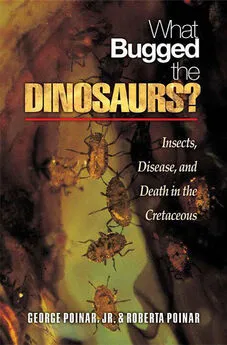

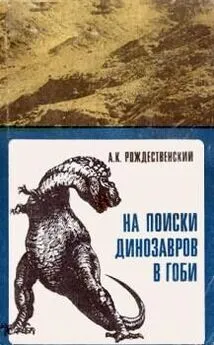
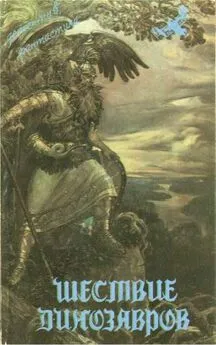
![Кейт Лаумер - Берег динозавров [Империум. Берег динозавров. Всемирный пройдоха]](/books/598305/kejt-laumer-bereg-dinozavrov-imperium-bereg-dino.webp)
